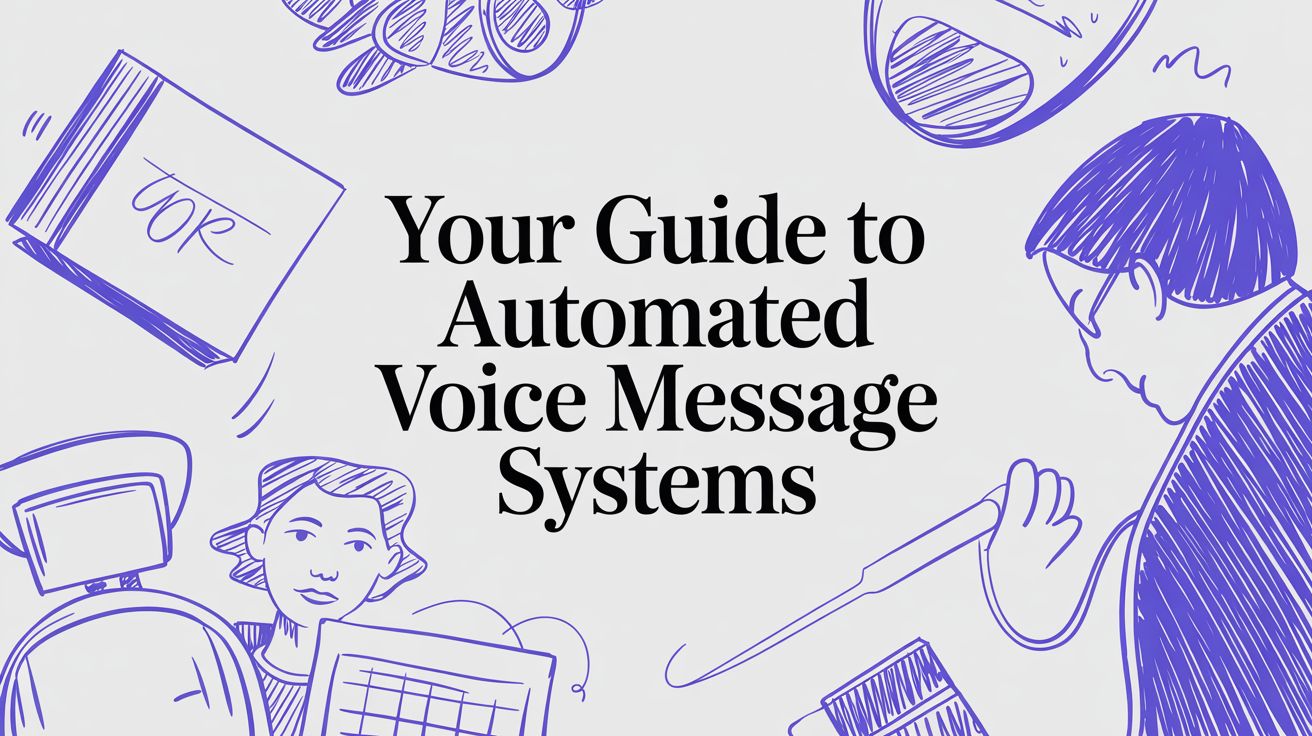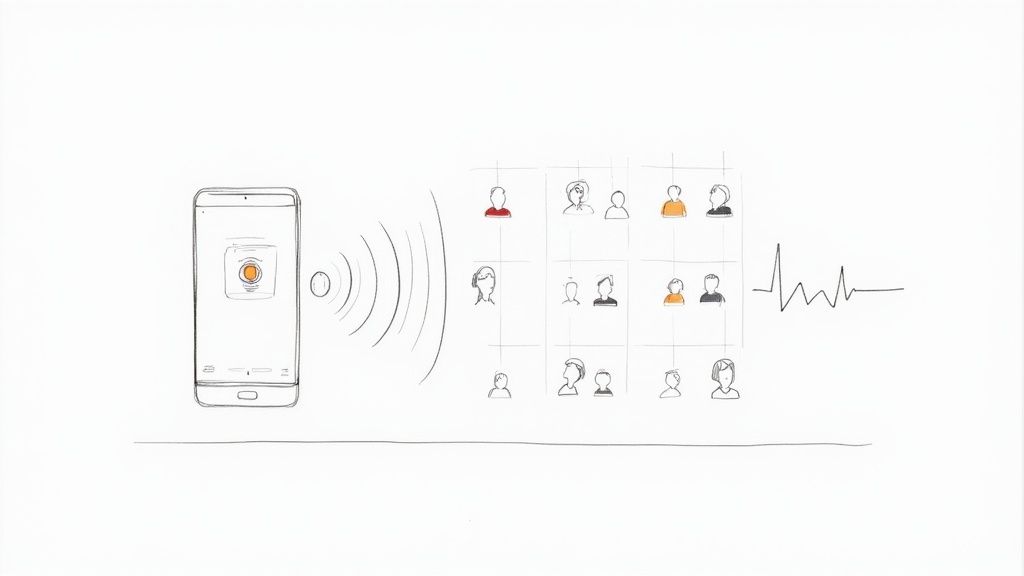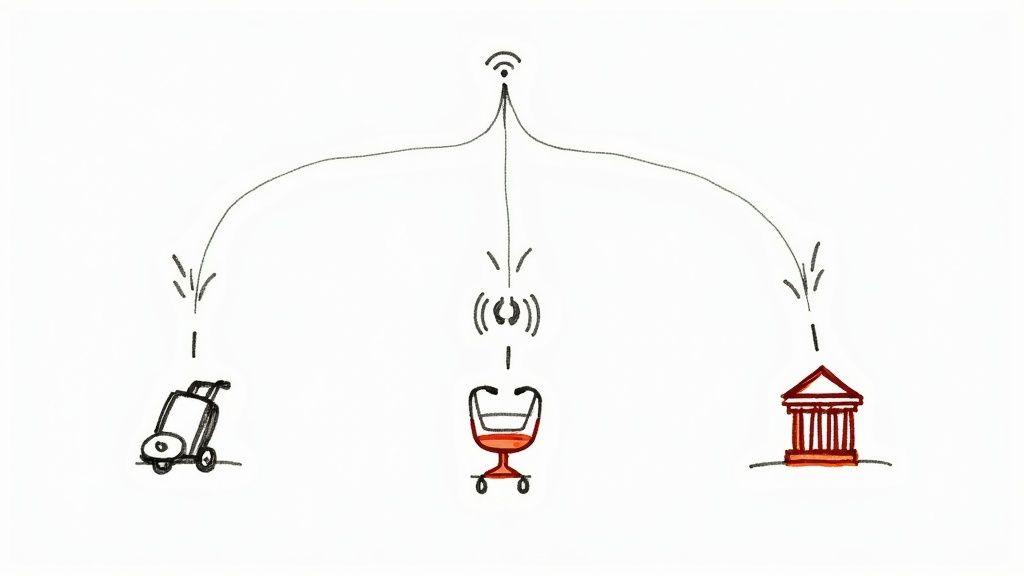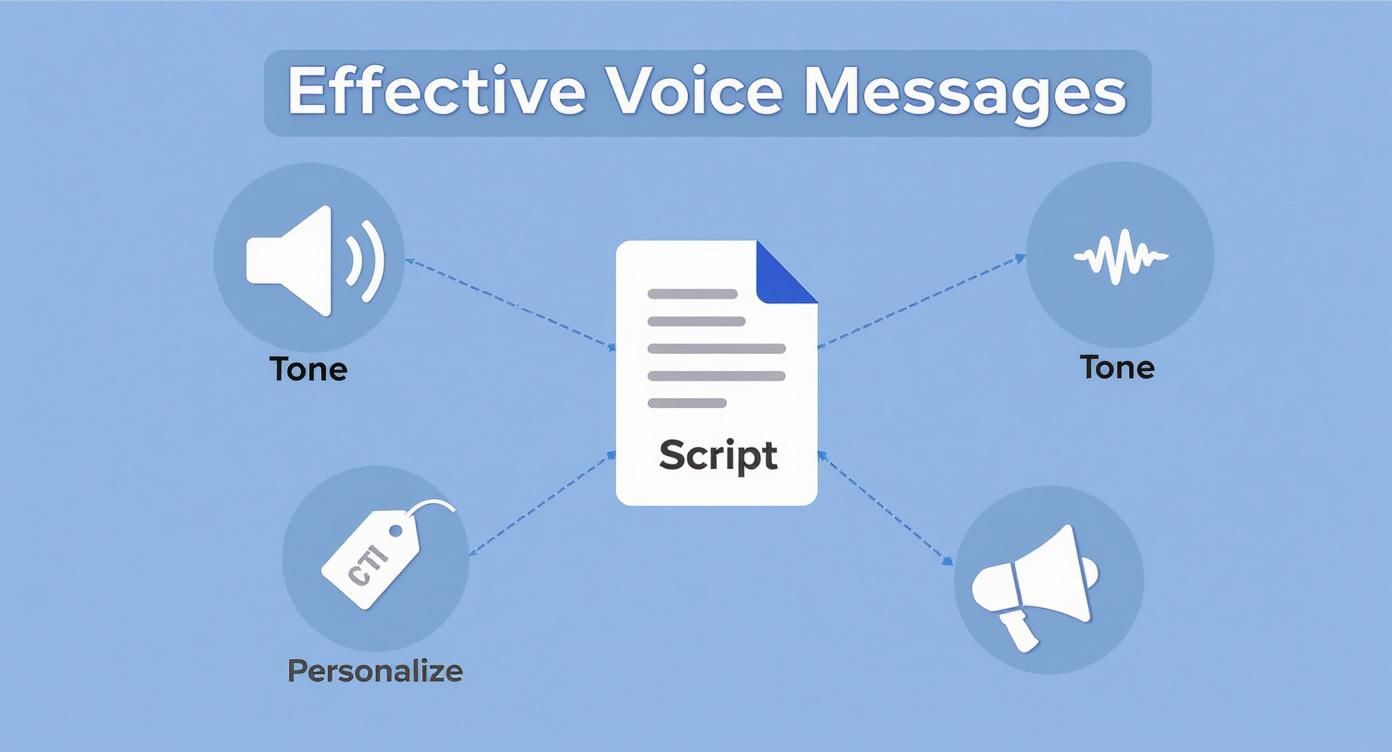Your Guide to Automated Voice Message Systems

Imagine reaching out to thousands of customers instantly, with a message that sounds both personal and perfectly consistent every single time. That’s the reality with a modern automated voice message system. Forget those old, clunky robocalls—this is a strategic tool for sending alerts, reminders, and promotions that actually connect. This guide provides actionable insights on how to leverage this technology for maximum impact.
How Automated Voice Messages Change the Game for Businesses
In a world where speed matters, communicating at scale is no longer optional; it’s essential for growth. An automated voice message system acts as a force multiplier for your team. Suddenly, a single person can deliver a flawless message to hundreds, or even thousands, of people at once.
This is all about streamlining your communication. It means delivering crisp, professional audio every time without anyone having to pick up a phone. For businesses, this translates directly into reclaiming countless hours previously lost to repetitive dialing. Your team can stop the mundane outreach and focus on higher-value conversations that genuinely need a human touch. The payoff? A more productive team and a healthier bottom line.

From Simple Text to Engaging Audio
The real magic happens when AI-driven platforms like Verbatik enter the picture. They can spin simple text into studio-quality audio that truly engages your listeners. This isn't just about being faster; it's about making your outreach better and far more personal.
Here’s a glimpse of the actionable features you can use:
- Unlimited Text-to-Speech: With Verbatik's unlimited text-to-speech, you can write, test, and send out endless versions of your message without booking a recording studio. This gives you the freedom to tweak and perfect your approach on the fly.
- Custom Voice Cloning: Keep your brand's sound consistent by cloning a familiar, trusted voice. With Verbatik, this feature makes even mass messages feel authentic and one-on-one.
- Dynamic Personalization: You can automatically weave in customer details—like names, appointment times, or order numbers—directly into the audio. Now that’s a personal touch.
An automated voice messaging system isn't just for one type of business; it's a huge asset for anyone who needs to communicate efficiently, especially call centers. It lets you send pre-recorded or text-to-speech messages to your contact lists instantly, saving a ton of time and resources.
This kind of smart communication helps you build stronger customer relationships, even when you're operating at scale. To dig deeper into the impact, see how automated phone calls for business can boost efficiency and save costs.
And if you're ready to unlock its full potential, integrating these systems via an API is the next step. Learn how to get started in our guide on integrating Verbatik's TTS API into your business. By embracing this technology, you're not just sending messages—you're building a smarter, more responsive way to connect.
Unlocking the Benefits of Voice Automation
Bringing an automated voice message system into your business does a lot more than just save a few minutes here and there. It's about fundamentally changing how your team works, letting you redirect their brainpower—your most valuable asset—to the stuff that actually grows the bottom line.
Think about all those routine calls: appointment reminders, shipping notifications, simple status updates. By automating them, you free up your people from the grind of repetitive tasks. This simple shift lets them dive into complex problem-solving, nurture customer relationships, or handle high-stakes conversations that need a real human on the other end.
Drastically Reduce Operational Costs
The financial upside of voice automation is hard to ignore. When you can handle thousands of calls at once without someone manually dialing, you cut way down on the staffing costs for outbound campaigns. This approach also slashes the kinds of errors that creep in with manual dialing, making sure every single message goes out exactly as intended.
Just look at the evolution of voicemail. For decades, it was a staple. Now, the entire market is sprinting towards cloud-based solutions because they’re cheaper and more accessible. In fact, the global voicemail service market is projected to hit $2.5 billion by 2025, with a steady 12% annual growth. That’s a clear signal that businesses are moving to smarter, automated communication that doesn't rely on clunky old hardware.
By automating routine outreach, businesses can reassign agents to handle more intricate customer inquiries, directly improving service quality while controlling headcount expenses. This is a direct path to leaner, more efficient operations.
And as you start reaching a global audience with automated messages, it pays to be smart about your costs. It's worth looking into the cheapest ways to call internationally using VoIP to really make your budget work harder.
Amplify Your Reach and Scalability
Maybe the biggest win here is the raw power of scale. With voice automation, a small team can suddenly talk to thousands—or even hundreds of thousands—of people without breaking a sweat. It completely changes the game.
This is where a tool like Verbatik really shines. It’s built to help you scale your communications effortlessly. Here's a set of actionable insights on how to leverage its features:
- Unlimited Text-to-Speech: Verbatik offers unlimited text-to-speech, allowing you to create and send out endless versions of a message to test what works best, all without extra production fees.
- Instant Voice Cloning: Keep your brand's voice consistent across every single message with Verbatik's voice cloning. Using a familiar voice makes even mass communications feel a bit more personal and trustworthy.
- Effortless Integration: Hook it up to your existing software to send out messages automatically based on customer actions, like a recent purchase or an abandoned cart.
This kind of scalability ensures your communication strategy can keep up as your business grows, instead of being the thing that holds you back. For a deeper dive, check out our guide on leveraging text-to-speech technology for business growth. At the end of the day, it's about getting more done with less and building a communication engine that works for you 24/7.
Automated Voice Messaging in Action

Talking about the benefits is great, but seeing an automated voice message system actually deliver results is where things get interesting. This isn't a one-trick pony. These systems are incredibly versatile, adapting to the unique needs of different industries—from driving retail sales to ensuring patients show up for their appointments.
Let's dive into some real-world examples of how businesses are putting voice automation to work. It all comes down to using the right tool for the job, whether that’s a custom voice clone that sounds just like your brand or a crisp, authoritative AI voice for critical alerts.
Driving Sales and Engagement in Retail
Retail moves fast. In a world of overflowing inboxes and ignored notifications, a timely voice message can be the difference between a record sales day and a missed opportunity. It cuts through the noise like nothing else.
Think about an online store launching a 24-hour flash sale. They could send an email, sure, but why not guarantee the message gets heard? With a platform like Verbatik, they can instantly send a voice alert to thousands of customers. Even better, they can use its voice cloning feature to make it personal.
- Goal: Kickstart a flash sale and generate immediate revenue.
- Action: Send a targeted, automated voice message to every loyalty program member.
- Benefit: Achieves far higher engagement than email alone while creating a powerful sense of urgency.
This direct-to-voicemail (or live call) approach gets the word out fast. And since Verbatik offers unlimited text-to-speech, the marketing team can A/B test different scripts to see what works best without worrying about extra costs.
Reducing No-Shows in Healthcare
For any healthcare provider, a missed appointment isn't just a scheduling headache; it's lost revenue and a disruption to patient care. Automated voice messages offer a simple, professional, and highly effective way to send appointment reminders.
Imagine a dental clinic scheduling a voice message to go out 48 hours before every appointment. The call can confirm the date and time and even ask the patient to press a key to confirm or reschedule. It’s a proactive step that makes a huge difference in no-show rates.
A friendly, human-sounding reminder feels far more personal and is harder to ignore than a generic text. It strengthens the patient relationship while protecting the clinic's schedule.
Using a warm, clear AI voice makes the message sound professional and reassuring, improving the patient experience and freeing up the front desk staff from making endless manual calls. You can achieve this by using a service with quality voice options or Verbatik's voice cloning for a familiar sound.
Combating Fraud in Financial Services
When it comes to financial security, every second counts. Banks and credit card companies are using automated voice messages to issue instant fraud alerts the moment their systems detect suspicious activity.
If a customer's card is suddenly used in another country, an automated call can be triggered in real-time. The message immediately asks the cardholder to verify the transaction. This gives them the power to approve it or flag it as fraud on the spot, stopping criminals in their tracks. It’s a crucial layer of modern security and a great example of customer service transformation with TTS technology.
These examples just scratch the surface. Voice automation is proving its value across countless sectors by solving specific, tangible problems.
Here’s a quick look at how different industries are putting automated voice messages to work.
Automated Voice Message Use Cases by Industry
| Industry | Use Case Example | Primary Goal |
|---|---|---|
| Retail & E-commerce | Flash sale alerts, order status updates, loyalty rewards | Drive urgent sales & improve customer experience |
| Healthcare | Appointment reminders, prescription refill notifications | Reduce no-shows & increase patient compliance |
| Financial Services | Fraud alerts, payment reminders, policy updates | Enhance security & reduce late payments |
| Logistics & Delivery | Delivery confirmations, scheduling notifications | Streamline operations & improve communication |
| Hospitality | Reservation confirmations, special offers for guests | Boost bookings & enhance the guest experience |
| Education | School closure alerts, event reminders for parents | Ensure community safety & improve engagement |
As you can see, the applications are broad and impactful. Any business that needs to communicate critical, time-sensitive information can find a powerful ally in automated voice messaging.
Creating Voice Messages That Actually Connect
An automated voice message shouldn't sound like a robot. It's a direct line to your customer, and to be effective, it needs to feel personal, clear, and genuinely useful. The whole game is about making mass communication feel like a one-on-one conversation.
This all starts with a script that gets straight to the point. Keep it short, simple, and build it around a single, powerful call-to-action. Whether you're sending an appointment reminder or announcing a flash sale, clarity is your best friend.
Scripting for Success
Before you hit record, your script has to be sharp. A rambling, confusing message is a deleted message. A tight, focused one, on the other hand, gets results.
Here’s a simple framework that works every time:
- Introduce Yourself Immediately: "Hi, this is [Your Company Name]." This builds instant trust and lets the listener know who's calling.
- State Your Purpose Clearly: Get right to it. "This is a friendly reminder of your appointment..." or "We're calling with a special offer just for you..."
- Give Only the Essentials: Stick to the need-to-know details, like a date, time, or specific discount. Don't overcomplicate it.
- End with a Clear Call-to-Action (CTA): Tell them exactly what to do next. Should they press 1 to confirm? Visit your website? Call you back?
With a platform like Verbatik, you can use the unlimited text-to-speech feature to try out different scripts. This lets you tweak and test your message until you find what works best, all without spending a dime on production.
Choosing the Right Voice for Your Message
The voice you pick is just as critical as the words you write. It's the personality of your brand. A fraud alert needs a serious, authoritative tone, while a promotion for a summer sale should sound upbeat and friendly.
Verbatik gives you a massive library of AI voices to choose from, but the real magic is in its voice cloning feature. Imagine cloning the voice of your CEO or a well-known brand ambassador. Suddenly, every automated message feels authentic and consistent, forging a much stronger connection with your audience.
The technology here is moving incredibly fast. The global voice recognition market, which is the engine behind all of this, was valued at $12 billion in 2022 and is expected to hit $50 billion by 2029. You can dig into more stats on voice AI's growth at verloop.io to see why getting the voice right is becoming such a huge deal.
Making It Personal at Scale
The final piece of the puzzle is personalization. Sending the exact same message to thousands of people just feels cold. Thankfully, today's systems let you insert dynamic details that make every call feel unique.
Using simple personalization tokens, you can automatically add specific information right into your script:
- Customer names
- Appointment dates and times
- Order numbers
- Specific product details
This is how a generic "Your order has shipped" becomes a much more powerful: "Hi, Sarah. Your new running shoes, order number 8675, have just been shipped." It’s a small change, but it makes customers feel seen and valued, which does wonders for engagement. If you're looking to take your audio to the next level, our guide on 10 essential voiceover tips for creating professional-quality audio is a must-read.
Building a Cohesive Communication Strategy
An automated voice message shouldn't be a lone wolf. Think of it as one powerful instrument in a full orchestra—it works best when it plays in harmony with all your other communication channels to create a seamless customer experience. It’s the specialized tool you pull out when you need to make the biggest impact.
The real magic happens when you weave these channels together. Imagine an email campaign announcing a new product. A few days later, you could send a targeted voice message to your most engaged subscribers, giving them an exclusive early-bird discount. This layered approach helps your message cut right through the digital noise.
Integrating Voice into Your Existing Stack
A common worry is that adding voice automation means ripping out and replacing your current systems. That's not the case at all. It’s about enhancing what you already have, not starting from scratch. You can easily layer powerful, AI-generated voice capabilities on top of the platforms you rely on every day, like your VoIP system or CRM.
This integration makes your communication truly responsive. For instance, if a critical SMS alert about a service outage isn't opened after 15 minutes, the system can automatically trigger a voice call. This ensures the message gets through. Voice becomes an intelligent safety net, adapting to customer behavior in real time.
The goal is to build a system where each channel supports the others. Voice becomes the high-impact tool for urgent alerts, personal follow-ups, or cutting through the clutter when other channels fail to get a response.
We're seeing a huge trend of voice automation merging with Voice over Internet Protocol (VoIP) platforms. VoIP is exploding, with the market expected to rocket past $400 billion by 2034. As AI features like real-time transcription become standard, having an automated voice message in your toolkit becomes even more powerful. You can learn more about the rapid expansion of VoIP technology at sqmagazine.co.uk.
Crafting a Unified Customer Journey
A smart strategy ensures every touchpoint feels connected and consistent. With a tool like Verbatik, you can pull this off without breaking a sweat. Its unlimited text-to-speech and voice cloning features let you maintain a perfect, on-brand voice for every single message, no matter the channel.
This concept map breaks down the key ingredients for an effective automated voice message that fits perfectly into your wider strategy.

As you can see, it all comes down to the fundamentals: a strong script, personalized content, the right tone, and a crystal-clear call-to-action. These are the pillars of any voice message that actually gets results.
To bring this all to life, developers and businesses lean on powerful APIs to build these custom connections. If you're ready to plug voice into your own systems, our guide on how to use a text-to-speech API gives you the technical roadmap. By weaving voice into your workflow, you create a more responsive, engaging, and effective communication engine that boosts engagement across the entire customer journey.
Frequently Asked Questions
Jumping into any new tech always comes with a few questions. Let's clear the air and tackle the most common things businesses ask when they start looking into an automated voice message system. We'll give you the straight answers to help you see how tools like Verbatik make this whole process simpler than you think.
How Much Does An Automated Voice Message System Cost?
The price tag can be all over the place, depending on who you go with. Some services will nickel-and-dime you for every single message, which adds up fast when you start sending more.
But newer platforms like Verbatik have a much more predictable approach. They offer features like unlimited text-to-speech and voice cloning, meaning you can create, test, and tweak endless message variations without the meter running. This way, you can actually budget for your outreach without worrying about surprise fees.
Is This Technology Difficult To Set Up?
Honestly? Not anymore. Most modern systems are built to be incredibly straightforward. You can usually be up and running in a few minutes flat.
Just sign up, upload your contact list, and then either record your message or just type it out for an AI voice to read. Converting text to audio is as easy as a copy-and-paste. This kind of user-friendly design means you can skip the technical headaches and get right to crafting a great message.
The key is to choose a provider that offers an intuitive interface. You should spend your time connecting with customers, not fighting with complicated software.
Are Automated Voice Messages Legally Compliant?
This is a big one, and it’s smart to ask. The short answer is: it depends on where you are and what you’re sending.
Laws like the Telephone Consumer Protection Act (TCPA) in the U.S. have very specific rules, especially for marketing calls—you'll often need written consent beforehand. But informational messages, like appointment reminders or fraud alerts, usually fall under different guidelines. It's always a good idea to chat with a legal pro to make sure your campaigns are fully compliant with the rules in your area.
Can The Voices Sound Truly Human?
Absolutely. The era of clunky, robotic voices is long gone. Today's AI platforms use sophisticated neural networks to generate speech that’s incredibly lifelike, full of the natural pauses and tones you'd hear in a real conversation.
Even better, services like Verbatik offer voice cloning. This lets you create a perfect digital copy of a real person’s voice—maybe your CEO or a trusted brand figure. It makes every automated voice message sound genuinely authentic and aligned with your brand, turning mass communication into something that feels surprisingly personal.
Ready to see how lifelike, scalable voice messages can change your communication game? Explore Verbatik's powerful text-to-speech and voice cloning tools and start creating studio-quality audio in seconds. Build more engaging connections with your audience today by visiting https://verbatik.com.
